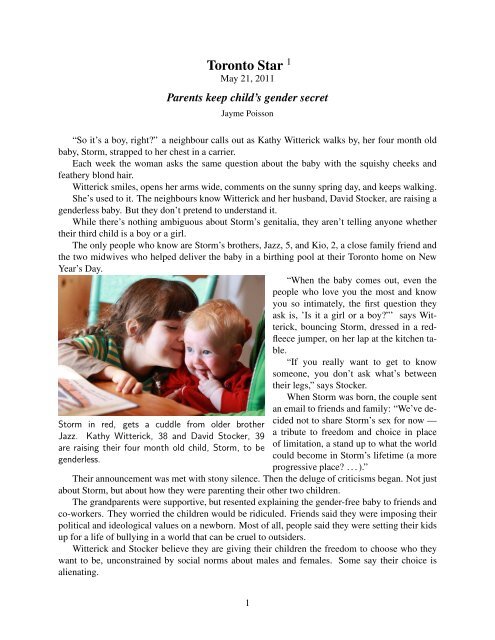Toronto Star 1
Toronto Star 1
Toronto Star 1
You also want an ePaper? Increase the reach of your titles
YUMPU automatically turns print PDFs into web optimized ePapers that Google loves.
<strong>Toronto</strong> <strong>Star</strong> 1May 21, 2011Parents keep child’s gender secretJayme Poisson“So it’s a boy, right?” a neighbour calls out as Kathy Witterick walks by, her four month oldbaby, Storm, strapped to her chest in a carrier.Each week the woman asks the same question about the baby with the squishy cheeks andfeathery blond hair.Witterick smiles, opens her arms wide, comments on the sunny spring day, and keeps walking.She’s used to it. The neighbours know Witterick and her husband, David Stocker, are raising agenderless baby. But they don’t pretend to understand it.While there’s nothing ambiguous about Storm’s genitalia, they aren’t telling anyone whethertheir third child is a boy or a girl.The only people who know are Storm’s brothers, Jazz, 5, and Kio, 2, a close family friend andthe two midwives who helped deliver the baby in a birthing pool at their <strong>Toronto</strong> home on NewYear’s Day.“When the baby comes out, even thepeople who love you the most and knowyou so intimately, the first question theyask is, ’Is it a girl or a boy?”’ says Witterick,bouncing Storm, dressed in a redfleecejumper, on her lap at the kitchen table.“If you really want to get to knowsomeone, you don’t ask what’s betweentheir legs,” says Stocker.When Storm was born, the couple sentan email to friends and family: “We’ve decidednot to share Storm’s sex for now —Storm in red, gets a cuddle from older brotherJazz. Kathy Witterick, 38 and David Stocker, 39a tribute to freedom and choice in placeare raising their four month old child, Storm, to beof limitation, a stand up to what the worldgenderless.could become in Storm’s lifetime (a moreprogressive place? . . . ).”Their announcement was met with stony silence. Then the deluge of criticisms began. Not justabout Storm, but about how they were parenting their other two children.The grandparents were supportive, but resented explaining the gender-free baby to friends andco-workers. They worried the children would be ridiculed. Friends said they were imposing theirpolitical and ideological values on a newborn. Most of all, people said they were setting their kidsup for a life of bullying in a world that can be cruel to outsiders.Witterick and Stocker believe they are giving their children the freedom to choose who theywant to be, unconstrained by social norms about males and females. Some say their choice isalienating.1
In an age where helicopter parents hover nervously over their kids micromanaging their lives,and tiger moms ferociously push their progeny to get into Harvard, Stocker, 39, and Witterick, 38,believe kids can make meaningful decisions for themselves from a very early age.“What we noticed is that parents make so many choices for their children. It’s obnoxious,” saysStocker.Jazz and Kio have picked out their own clothes in the boys and girls sections of stores sincethey were 18 months old. Just this week, Jazz unearthed a pink dress at Value Village, which heloves because it “really poofs out at the bottom. It feels so nice.” The boys decide whether to cuttheir hair or let it grow.Like all mothers and fathers, Witterick and Stocker struggle with parenting decisions. The boysare encouraged to challenge how they’re expected to look and act based on their sex.“We thought that if we delayed sharing that information, in this case hopefully, we might knockoff a couple million of those messages by the time that Storm decides Storm would like to share,”says Witterick.They don’t want to isolate their kids from the world, but, when it’s meaningful, talk aboutgender.This past winter, the family took a vacation to Cuba with Witterick’s parents. Since theyweren’t fluent in Spanish, they flipped a coin at the airport to decide what to tell people. It landedon heads, so for the next week, everyone who asked was told Storm was a boy. The languagechanged immediately. “What a big, strong boy,” people said.The moment a child’s sex is announced, so begins the parade of pink and barrage of blue. Tutusand toy trucks aren’t far behind. The couple says it only intensifies with age.“In fact, in not telling the gender of my precious baby, I am saying to the world, ’Please canyou just let Storm discover for him/herself what s(h) wants to be?!.” Witterick writes in an email.Stocker teaches at City View Alternative, a tiny school west of Dufferin Grove Park, with fourteachers and about 60 Grade 7 and 8 students whose lessons are framed by social-justice issuesaround class, race and gender.When Kio was a baby, the family travelled through the mountains of Mexico, speaking withthe Zapatistas, a revolutionary group who shun mainstream politics as corrupt and demand greaterindigenous rights. In 1994, about 150 people died in violent clashes with the Mexican military, butthe leftist movement has been largely peaceful since.Last year, they spent two weeks in Cuba, living with local families and learning about therevolution. Witterick has worked in violence prevention, giving workshops to teachers. Thesedays, she volunteers, offering breastfeeding support. At the moment, she is a full-time mom.Both come from liberal families. Stocker grew up listening to Free to Be . . . You and Me, a1972 record with a central message of gender neutrality. Witterick remembers her brother muckingaround with gender as a teen in the ’80s, wearing lipstick and carrying handbags like David Bowieand Mick Jagger.The family lives in a cream-coloured two-storey brick home in the city’s Junction Triangleneighbourhood. Their front porch is crammed with bicycles, including Kio’s pink and purpletricycle. Inside, it’s organized clutter. The children’s arts and crafts projects are stacked in thebookcases, maps hang on the walls and furniture is well-used and of a certain vintage.Upstairs they co-sleep curled up on two mattresses pushed together on the floor of the masterbedroom, under a heap of mismatched pillows and blankets. During the day, the kids build fortswith the pillows and pretend to walk a tightrope between the mattresses.2
On a recent Tuesday, the boys finish making paper animal puppets and a handmade sign tocelebrate their dad’s birthday. “I love to do laundry with dad,” reads one message. They nuzzleStorm, splayed out on the floor. The baby squeals with delight.Witterick practices unschooling, an offshoot of home-schooling centered on the belief thatlearning should be driven by a child’s curiosity. There are no report cards, no textbooks andno tests. For unschoolers, learning is about exploring and asking questions, “not something thathappens by rote from 9 a.m. to 3 p.m. weekdays in a building with a group of same-age people,planned, implemented and assessed by someone else,” says Witterick. The fringe movement isgrowing. An unschooling conference in <strong>Toronto</strong> drew dozens of families last fall.The kids have a lot of say in how their day unfolds. They decide if they want to squish throughthe mud, chase garter snakes in the park or bake cupcakes.Jazz — soft-spoken, with a slight frame and curious brown eyes — keeps his hair long, preferringto wear it in three braids, two in the front and one in the back, even though both his parentshave close-cropped hair. His favourite colour is pink, although his parents don’t own a piece ofpink clothing between them. He loves to paint his fingernails and wears a sparkly pink stud in oneear, despite the fact his parents wear no nail polish or jewelry.Kio keeps his curly blond hair just below his chin. The 2-year-old loves purple, although he’shappiest in any kind of pyjama pants.“As a result, Jazz and now Kio are almost exclusively assumed to be girls,” says Stocker, addinghe and Witterick don’t out them. It’s the boys’ choice whether they want to offer a correction.On a recent trip to High Park, Jazz, wearing pink shorts, patterned pink socks and brightlycoloured elastics on his braids, runs and skips across the street.“That’s a princess!” says a smiling crossing guard, ushering the little boy along. “And that’s aprincess, too,” she says again, pointing at Kio with her big red sign.Jazz doesn’t mind. One of his favourite books is 10,000 Dresses, the story of a boy who lovesto dress up. But he doesn’t like being called a girl. Recently, he asked his mom to write a note onhis application to the High Park Nature Centre because he likes the group leaders and wants themto know he’s a boy.Jazz was old enough for school last September, but chose to stay home. “When we wouldgo and visit programs, people — children and adults — would immediately react with Jazz overhis gender,” says Witterick, adding the conversation would gravitate to his choice of pink or hishairstyle.That’s mostly why he doesn’t want to go to school. When asked if it upsets him, he nods, butdoesn’t say more.Instead he grabs a handmade portfolio filled with his drawings and poems. In its pages is abooklet written under his pseudonym, the “Gender Explorer.” In purple and pink lettering, adornedwith butterflies, it reads: “Help girls do boy things. Help boys do girl things. Let your kid bewhoever they are!”Storm was named after whipped winds and dark rain clouds, because they are beautiful andtransformative.“When I was pregnant, it was really this intense time around Jazz having experiences withgender and I was feeling like I needed some good parenting skills to support him through that,”says Witterick.It began as a offhand remark. “Hey, what if we just didn’t tell?” And then Stocker found abook in his school library called X: A Fabulous Child’s Story by Lois Gould. The book, published3
in 1978, is about raising not a boy or a girl, but X. There’s a happy ending here. Little X — wholoved to play football and weave baskets — faces the taunting head on, proving that X is the mostwell-adjusted child ever examined by “an impartial team of Xperts.”“It became so compelling it was almost like, How could we not?” says Witterick.There are days when their decisions are tiring, shackling even. “We spend more time than weshould providing explanations for why we do things this way,” says Witterick. “I regret that (Jazz)has to discuss his gender before people ask him meaningful questions about what he does and seesin this world, but I don’t think I am responsible for that — the culture that narrowly defines whathe should do, wear and look like is.”Longtime friend Ayal Dinner, 35, a father two young boys, was surprised to hear the couple’sannouncement when Storm was born, but is supportive.“I think it’s amazing that they’re willing to take on challenging people in this way,” says Dinner.“While they are political and ideological about these things, they’re also really thinking about whatit means and struggling with it as they go along.”Dinner understands why people may find it extreme. “Although I can see the criticism of ’Thisis going to be hard on my kid,’ it’s great to say, ’I love my kid for whoever they are.”’On a recent trip to Hamilton, Jazz was out of earshot when family friend Denise Hansen overheardtwo little girls at the park say they didn’t want to play with a “girl-boy.” Then, there wasthe time a saleswoman at a second-hand shop refused to sell him a pink feather boa. “Surely youwon’t buy it for him — he’s a boy!” said the woman. Shocked, and not wanting to upset Jazz,Witterick left the store.Parents talk about the moment they realize they would throw themselves in front of a speedingtruck to save their child from harm, yet battle the instinct to overprotect. They want to encourageindependence. They hope people won’t be mean. They pray they aren’t bullied. No parent wouldever wish that for their child.On a night after she watched her husband of 11 years and the boys play with sparklers afterdark, Witterick, in a reflective mood, writes to say we are all mocked at some point for the way welook, the way we dress and the way we think.“When faced with inevitable judgment by others, which child stands tall (and sticks up forothers) — the one facing teasing despite desperately trying to fit in, or the one with a strong senseof self and at least two ’go-to’ adults who love them unconditionally? Well, I guess you knowwhich one we choose.”Diane Ehrensaft is a California-based psychologist and mother of Jesse, a “girlyboy” whoturned his trucks into cradles and preferred porcelain dolls over soldiers when he was a child. Hernewly published book, Gender Born, Gender Made, is a guide for parents of nonconforming kids.She believes parents should support gender-creative children, which includes the transgendered,who feel born in the wrong bodies, and gender hybrids, who feel they are part girl and partboy. Then there are gender “smoothies,” who have a blended sense of gender that is purely “them.”Ehrensaft believes there is something innate about gender, and points to the ’70s, when parentsexperimented by giving dolls to boys and trucks to girls.“It only worked up to a certain extent. Some girls never played with the trucks, some boysweren’t interested in ballet . . . It was a humbling experiment for us because we learned we don’thave the control that we thought we did.”But she worries by not divulging Storm’s sex, the parents are denying the child a way to positionhimself or herself in a world where you are either male, female or in between. In effect they have4
created another category: Other than other. And that could marginalize the child.“I believe that it puts restrictions on this particular baby so that in this culture this baby will bea singular person who is not being given an opportunity to find their true gender self, based on alsowhat’s inside them.”Ehrensaft gets the “What the heck?!” reaction people may have when they hear about Storm.“I think it probably makes people feel played with to have that information withheld from them.”While she accepts and supports Jazz’s freedom “to be who he is,” she’s concerned about askingtwo small boys to keep a secret about the baby of the family. “For very young children, just in theirbrains, they’re not ready to do the kind of sophisticated discernment we do about when a secret isnecessary.”Jazz says it’s not difficult. He usually just calls the baby Storm.Dr. Ken Zucker, considered a world expert on gender identity and head of the gender identityservice for children at <strong>Toronto</strong>’s Centre for Addiction and Mental Health, calls this a “social experimentof nurture.” The broader question, he says, is how much influence parents have on theirkids. If Ehrensaft leans toward nature, Zucker puts more emphasis on nurture. Even when parentsdon’t make a choice, that’s still a choice, and one that can impact the children.When asked what psychological harm, if any, could come from keeping the sex of a childsecret, Zucker said: “One will find out.”The couple plan to keep Storm’s sex a secret as long as Storm, Kio and Jazz are comfortablewith it. In the meantime, philosophy and reality continue to collide.Out with the kids all day, Witterick doesn’t have the time or the will to hide in a closet everytime she changes Storm’s diaper. “If (people) want to peek, that’s their journey,” she says.There are questions about which bathroom Storm will use, but that is a couple of years off.Then there is the “tyranny of pronouns,” as they call it. They considered referring to Storm as “Z”.Witterick now calls the baby she, imagining the “s” in brackets.For the moment, it feels right.“Everyone keeps asking us, ’When will this end?”’ says Witterick. “And we always turn thequestion back. Yeah, when will this end? When will we live in a world where people can makechoices to be whoever they are?”jpoisson@thestar.ca5
The New York Times 2August 8, 2012What’s So Bad About a Boy Who Wants to Wear a Dress?By RUTH PADAWERAbove, a boy prepares for a fashion show at a campfor gender-variant children and their families.The night before Susan and Rob allowed their son to go to preschool in a dress, they sent ane-mail to parents of his classmates. Alex, they wrote, “has been gender-fluid for as long as wecan remember, and at the moment he is equally passionate about and identified with soccer playersand princesses, superheroes and ballerinas (not to mention lava and unicorns, dinosaurs and glitterrainbows).” They explained that Alex had recently become inconsolable about his parents’ banon wearing dresses beyond dress-up time. After consulting their pediatrician, a psychologist andparents of other gender-nonconforming children, they concluded that “the important thing was toteach him not to be ashamed of who he feels he is.” Thus, the purple-pink-and-yellow-stripeddress he would be wearing that next morning. For good measure, their e-mail included a link toinformation on gender-variant children.When Alex was 4, he pronounced himself “a boy and a girl,” but in the two years since, hehas been fairly clear that he is simply a boy who sometimes likes to dress and play in conventionallyfeminine ways. Some days at home he wears dresses, paints his fingernails and plays withdolls; other days, he roughhouses, rams his toys together or pretends to be Spider-Man. Even hismovements ricochet between parodies of gender: on days he puts on a dress, he is graceful, almostdancerlike, and his sentences rise in pitch at the end. On days he opts for only “boy” wear, heheads off with a little swagger. Of course, had Alex been a girl who sometimes dressed or playedin boyish ways, no e-mail to parents would have been necessary; no one would raise an eyebrowat a girl who likes throwing a football or wearing a Spider-Man T-shirt.There have always been people whodefy gender norms. Late-19th-centurymedical literature described female “inverts”as appallingly straightforward, witha “dislike and sometimes incapacity forneedlework” and “an inclination and tastefor the sciences”; male inverts were “entirelyaverse to outdoor games.” Bythe mid-20th century, doctors were trying“corrective therapy” to extinguish atypicalgender behaviors. The goal was preventingchildren from becoming gay or transgender,a term for those who feel they wereborn in the wrong body.Many parents and clinicians now rejectcorrective therapy, making this the first generation to allow boys to openly play and dress (tovarying degrees) in ways previously restricted to girls — to exist in what one psychologist called“that middle space” between traditional boyhood and traditional girlhood. These parents havedrawn courage from a burgeoning Internet community of like-minded folk whose sons identify asboys but wear tiaras and tote unicorn backpacks. Even transgender people preserve the traditional6
inary gender division: born in one and belonging in the other. But the parents of boys in thatmiddle space argue that gender is a spectrum rather than two opposing categories, neither of whichany real man or woman precisely fits.“It might make your world more tidy to have two neat and separate gender possibilities,” oneNorth Carolina mother wrote last year on her blog, “but when you squish out the space between,you do not accurately represent lived reality. More than that, you’re trying to ‘squish out’ my kid.”The impassioned author of that blog, Pink Is for Boys, is careful to conceal her son’s identity,as were the other parents interviewed for this article. As much as these parents want to nurtureand defend what makes their children unique and happy, they also fear it will expose their sonsto rejection. Some have switched schools, changed churches and even moved to try to shieldtheir children. That tension between yielding to conformity or encouraging self-expression isfelt by parents of any child who differs from the norm. But parents of so-called pink boys feelanother layer of anxiety: given how central gender is to identity, they fear the wrong parentingdecision could devastate their child’s social or emotional well-being. The fact that there is stillsubstantial disagreement among prominent psychological professionals about whether to squelchunconventional behavior or support it makes those decisions even more wrenching.Many of the parents who allow their children to occupy that “middle space” were sociallyliberal even before they had a pink boy, quick to defend gay rights and women’s equality andto question the confines of traditional masculinity and femininity. But when their sons upendconventional norms, even they feel disoriented. How could my own child’s play — somethingordinarily so joyous to watch — stir up such discomfort? And why does it bother me that he wantsto wear a dress?Despite the confident tone of the letter Alex’s parents wrote to the preschool parents, Susan wasterrified. She feared Alex’s fascination with femininity would make him a target of bullying, evenin the progressive New England town where they live. She felt tortured by statistics that indicatedgay and transgender teenagers, either of which she figured Alex might become, were much morelikely to take drugs and commit suicide. She began having panic attacks. “The whole thing wasvertiginous,” she said. “It’s hard to put a finger on why gender identity makes such a difference toour sense of who a person is, but it does. As a parent, it’s really destabilizing when that’s pulledout from under you. And I worried that if I was having a hard time wrapping my mind around mykid, and I love him more than life itself, then how would the rest of the world react to him?”Relatively little research on gender-nonconforming children has been conducted, making itimpossible to know how many children step outside gender bounds — or even where those boundsbegin. Studies estimate that 2 percent to 7 percent of boys under age 12 regularly display “crossgender”behaviors, though very few wish to actually be a girl. What this foretells about their futureis hard to know. By age 10, most pink boys drop much of their unconventional appearance andactivities, either because they outgrow the desire or subsume it. The studies on what happens inadulthood to boys who strayed from gender norms all have methodological limitations, but theysuggest that although plenty of gay men don’t start out as pink boys, 60 to 80 percent of pink boysdo eventually become gay men. The rest grow up to either become heterosexual men or becomewomen by taking hormones and maybe having surgery. Gender-nonconforming behavior of girls,however, is rarely studied, in part because departures from traditional femininity are so pervasiveand accepted. The studies that do exist indicate that tomboys are somewhat more likely thangender-typical girls to become bisexual, lesbian or male-identified, but most become heterosexualwomen.7
Alex was clearly in that small percentage of boys who trample gender barriers. At age 3, heinsisted on wearing gowns even after preschool dress-up time ended. He pretended to have longhair and drew pictures of girls with elaborate gowns and flowing tresses. By age 4, he sometimessobbed when he saw himself in the mirror wearing pants, saying he felt ugly.Worried, his mother scoured the Internet for information. She and Rob found much to supporttheir gut impulse to affirm rather than repress their son’s unconventional gender expression. Onlya few years ago, such encouragement would have been hard to find, but the gay rights movementhas made a big difference. Moreover, the visibility of transgender people — be it running for officeor tangoing on “Dancing With the <strong>Star</strong>s” — has provided an opening for those who fall betweengenders. Though acceptance is not yet widespread, many school districts and local governmentsnow ban discrimination based on gender identity or expression.Transgender activists have also pressed for changes in the psychiatric establishment, which stillofficially considers children’s distress over gender identity a mental illness. Now the AmericanPsychiatric Association is reviewing the diagnosis of “Gender Identity Disorder in Children” forthe next edition of the Diagnostic and Statistical Manual of Mental Disorders. Critics, though,condemn the association’s choice of Dr. Kenneth Zucker to lead the inquiry. Zucker is the headof a well-known gender-identity clinic in <strong>Toronto</strong> and the most prominent defender of traditionalinterventions for gender nonconformity. He urges parents to steer their children toward gendertypicaltoys, clothes and playmates and advises them to prohibit behaviors associated with theother sex. Zucker’s academic articles assert that while biology may predispose some children togender nonconformity, other factors — like trauma and emotional disorders — often play a role.Other contributing causes he cites include overprotective mothers, emotionally absent fathers ormothers who are hostile toward men.Transgender advocates and sympathetic clinicians argue that telling children in that middlespace to abolish their cross-gender interests makes them more distressed, not less. There is alsolittle to no evidence that therapeutic interventions change the trajectory of a child’s gender identificationor sexual orientation. Clinicians who oppose traditional treatments contend that significantgender nonconformity is akin to left-handness: unusual but not unnatural. Rather than urging childrento conform, they teach them how to respond to intolerance. They encourage parents to accepttheir children’s gender expression, especially because studies show that parental support helps toinoculate gender-atypical children against ostracism and deflated self-esteem.Just how many parents choose this approach over the traditional no-tolerance one is unknown.What is clear is that in the last few years, challenges to the conventional model have becomeincreasingly common in the United States and Europe, in medical publications and among professionalsand parents themselves. “The climate has changed,” said Edgardo Menvielle, head ofone of the world’s few programs for gender-nonconforming youth, at Children’s National MedicalCenter in Washington. “A lot of parents don’t even go to clinicians anymore. They go to Web sitesand listservs, which influence how they think about gender. More parents decide that making theirchild conform to a gender will damage his self-esteem, and I’d agree. I would argue it’s not evenethical to say to a child, ‘This is the gender you must be.’ ”In Washington, Menvielle runs a support group for parents that he founded with a psychotherapistnamed Catherine Tuerk. When Tuerk’s gender-atypical son was a child three decades ago, sheconsulted a psychiatrist, who told her to keep her son away from girl toys and girl playmates, andto encourage aggressive behavior. So she and her husband signed up their gentle boy for karateand soccer and took him to psychoanalysis four times a week for years. He became sullen and8
angry. At 21, he told his parents he was gay. In time, she and her husband viewed their efforts asunwitting abuse. Tuerk vowed to help others avoid the same mistakes.Alex’s mother, Susan, found Tuerk in her Internet search when Alex first begged to wear adress to preschool. After a long phone conversation with Tuerk, Susan bought her son a fewdresses. To Alex’s irritation, people on the street often mistook him for a girl. “I just hate beingmisunderstood,” he told his baby sitter. When his parents asked if he wanted them to refer to himas “she,” he said, “No, I’m still a he.”Susan and Rob wondered if Alex would eventually become transgender. They knew more doctorswere giving puberty-blocking hormones to pubescent children considering a transition to theother sex. The hormones not only buy time but also spare the young teenagers the angst of developingsecondary sex characteristics that feel terribly wrong to them. Even Zucker supports hormonesfor teenagers who want to become the opposite sex, because mounting evidence indicates it besteliminates their misery. Yet many question whether adolescents are mature enough to make suchlife-altering decisions, especially when the drugs’ long-term effects are unknown.Though Alex was a long way from facing those decisions, the possibility hovered in Susan’smind as she watched his emotional upheaval that autumn in preschool. He became obsessed witha particular lavender dress and fell apart whenever it was in the wash. Alarmed, Susan and Robdecided to limit dress days to Tuesdays and Saturdays, telling Alex he couldn’t fairly expect themto launder it more often. Their fuller reason was more complicated. For one thing, they didn’t havethe emotional strength to take him out in a dress every day, to deal with the double takes and theimplied judgments. For another, they had noticed how, depending on his mood and his clothing,Alex comported himself in very different gendered ways. While they continued to furnish Alexwith toys and activities from all across the gender spectrum, they hoped that more time in boyclothes might help him feel more comfortable with society’s expectations for his biological sex,especially given the likelihood that he’d grow into a male-identified adult.Still, it was hard not to wonder what Alex meant when he said he felt like a “boy” or a “girl.”When he acted in stereotypically “girl” ways, was it because he liked “girl” things, so figured hemust be a girl? Or did he feel in those moments “like a girl” (whatever that feels like) and thenconsolidate that identity by choosing toys, clothes and movements culturally ascribed to girls?Whatever the reasoning, was his obsession with particular clothes really any different than that oflegions of young girls who insist on dresses even when they’re impractical? Or any different thantomboys who are averse to those same clothes?No one knows why most children ease into their assigned gender roles so effortlessly and othersdo not. Hormone levels might play a role. One hint is provided by a rare genetic condition knownas congenital adrenal hyperplasia, or C.A.H. The condition produces high levels of androgens,including testosterone, early in gestation, and can create somewhat male-like genitalia in geneticfemales. Girls with C.A.H. are typically raised as females and given hormones to feminize, yetstudies show they are more physically active and aggressive than the average girl, and more likelyto prefer trucks, blocks and male playmates. Though most turn out to be heterosexual, womenwith C.A.H. are more likely to be lesbian or bisexual than women who weren’t bathed in prenatalandrogen.Genetics might also be a factor in gender expression. Researchers have compared the genderedbehavior of identical twins (who share 100 percent of their genes) with that of fraternal twins (whoshare roughly half). The largest study was a 2006 Dutch survey of twins, 14,000 at age 7 and 8,500at age 10. The study concluded that genes account for 70 percent of gender-atypical behavior in9
oth sexes. Exactly what is inherited, however, remains unclear: the specific behavior preferences,the impulse to associate with the other gender, the urge to reject limits imposed on them — orsomething else entirely.Whatever biology’s influence, expressions of masculinity and femininity are culturally andhistorically specific. In the 19th century, both boys and girls often wore dresses and long hair untilthey were 7. Colors weren’t gendered consistently. At times pink was considered a strong, andtherefore masculine, color, while blue was considered delicate. Children’s clothes for both sexesincluded lace, ruffles, flowers and kittens. That started to change in the early 20th century, writesJo Paoletti, a professor of American studies at the University of Maryland and author of “Pink andBlue: Telling the Boys From the Girls in America.” By then, some psychologists were arguing thatboys who identified too closely with their mothers would become homosexuals. At the same time,suffragists were pushing for women’s advancement. In response to these threatening social shifts,clothes changed to differentiate boys from their mothers and from girls in general. By the 1940s,dainty trimming had been purged from boys’ clothing. So had much of the color spectrum.Women, meanwhile, took to wearing pants, working outside the home and playing a widerarray of sports. Domains once exclusively masculine became more neutral territory, especiallyfor prepubescent girls, and the idea of a girl behaving “like a boy” lost its stigma. A 1998 studyin the academic journal Sex Roles suggests just how ordinary it has become for girls to exist inthe middle space: it found that 46 percent of senior citizens, 69 percent of baby boomers and 77percent of Gen-X women reported having been tomboys.These days, flouting gender conventions extends even to baby naming: first names that wereonce unambiguously masculine are now given to girls. The shift, however, almost never goes theother way. That’s because girls gain status by moving into “boy” space, while boys are taintedby the slightest whiff of femininity. “There’s a lot more privilege to being a man in our society,”says Diane Ehrensaft, a psychologist at the University of California, San Francisco, who supportsallowing children to be what she calls gender creative. “When a boy wants to act like a girl, itsubconsciously shakes our foundation, because why would someone want to be the lesser gender?”Boys are up to seven times as likely as girls to be referred to gender clinics for psychologicalevaluations. Sometimes the boys’ violation is as mild as wanting a Barbie for Christmas. Bycomparison, most girls referred to gender clinics are far more extreme in their atypicality: theywant boy names, boy pronouns and, sometimes, boy bodies.Some cultures develop categories for those whose behavior doesn’t fit gender conventions.In Samoa, biological males who adopt feminine mannerisms are accepted as a third sex, calledfa’afafine. In the U.S., some who occupy that “middle space” call themselves “genderqueer,” butit is hardly a well-established cultural concept.“People rely on gender to help understand the world, to make order out of chaos,” says JeanMalpas, who heads the Gender and Family Project at the Ackerman Institute in Manhattan. “It’sbeen a way of measuring someone’s well-being: ‘Are you adjusted? Do you fit? Or are youunhinged?’ The social categories of man/woman, boy/girl are fundamental, and when an individualchallenges that by blurring the lines, it’s very disorienting at first. It’s as if they’re questioning thelaws of gravity.”So it is for Moriko and her husband, who struggled for years to understand their son’s attractionto girls’ clothes even though it made him a social pariah. “I was sad and I was scared, really scared,”Moriko said. “This kind of stuff is not in ‘What to Expect When You’re Expecting.’ I didn’t knowwhat to do, what to think or what was going to happen.” They took their 7-year-old son to a New10
York City psychologist, hoping for guidance and support. Instead, the therapist blamed them fortheir son’s femininity, saying Moriko was emotionally detached and her husband too absent. Sheadvised them to confiscate the boy’s dolls and girlish clothes and to find him male friends. Theyfollowed her instructions, but their son was miserable, and they ultimately rejected the therapist’sanalysis. “It became clear this couldn’t be the right way,” Moriko said. “It was damaging all ofus.”By the time her son was 9, Moriko and another mother had started a support group for familieslooking to accept, not change, their children’s gender expression. They offered one room forparents to talk and another for the children to play. Today more than 20 families are in the group.A few of the kids now take hormone blockers. A few others have come out as gay. Moriko’s sonis still wavering.Moriko’s son will soon enter eighth grade in his Long Island public middle school. Most of hisfriends are girls, and he dresses just like them: skinny jeans, black eyeliner, light lipstick and offthe-shouldershirts from the girls’ department. (Moriko makes him wear a tank top underneath.)When his teachers asked which pronoun they should use when referring to him, he said masculine.But he doesn’t want to be called a boy, or a girl.“This is a kid who is smack in the middle,” Moriko said. “His feet are getting bigger, his voiceis starting to deepen. He doesn’t want to start blockers. We don’t really know what’s next.” Shesighed and then started to cry. “His therapist said to me, ‘I know you’ve been living without agender box for a very long time, and I know it’s frustrating and confusing, but right now, he justdoesn’t want to be in a box.’ I’m not trying to label him, but it’s hard not to wonder what he is, ifhe’s not a boy and he’s not a girl. Sometimes I worry that not being in a box isn’t healthy, either,even if the box is ‘gay’ or ‘genderqueer.’ I just want to be able to wrap my head around someconcept. I know I have to be patient, but sometimes I feel like an emotional hostage, because as hisparent, it’s my job to help him be whatever he wants to be, and I can’t do that if he doesn’t knowwhere he’s headed.”Gender nonconformity is a touchy subject, and parents who celebrate it in their children can bejudged harshly. When J. Crew ran an ad of its president painting her son’s toenails neon pink, withcopy that read, “Lucky for me, I ended up with a boy whose favorite color is pink,” one commentatorsaid she was exploiting her son “behind the facade of liberal, transgendered identity politics.”Then there was Kathy Witterick and David Stocker, the <strong>Toronto</strong> couple inadvertently caught ina critical spotlight when word spread that they wouldn’t reveal their newborn’s sex because theywanted to free him or her from gender expectations. The idea came from their 6-year-old son, Jazz,who has insisted for the last three years on picking his clothes from the girls’ section of the store.“I didn’t go into parenting thinking I wanted to deconstruct the notions of gender with mychildren,” Witterick told me. “I had enough life experience to know that the way we constructmasculinity sets men up to either be victimized because they’re wimps, or to be victimizers toprove they’re not. But I will freely admit to you that the first time Jazz selected a dress off the storeshelf, I did not know what to do. There were beads of sweat on my forehead.”Ellen R. and her 10-year-old son, Nick, live in a small New Jersey suburb. Nick sometimesspends hours a day drawing gowns for his 36 Barbies and designing them for himself or his dolls,using fabric, ribbon and rubber bands. For a while, Nick was able to keep his interest hidden. Butone day in second grade, a friend stopped by unexpectedly and saw Barbies sprawled in the livingroom. The boy ran out of the house. In school the following day announced to the class, “Nickplays with dolls.”11
“Everyone looked at me,” Nick told me. “I wanted to yell, but you’re not supposed to yell inschool. So I said it wasn’t true. But no one believed me.” He was quiet for a while, concentratingon an uncooperative lock of a Barbie’s hair. “He was my friend. That was the worst part of it.”In the two years since, Nick hasn’t had a single play date.Ellen’s conviction that Nick shouldn’t be ashamed of who he is runs deep. Yet she nonethelessbattles a fear of being shunned. “When your kid’s girly in preschool, the other parents might thinkit’s cute. But it’s not cute once your kid is in elementary school, especially the older he gets. I sitnext to parents at events, I volunteer with the P.T.A., and it’s hard not to wonder, are they out theremaking fun of me and my kid?”For other parents, the discomfort is even more intense. When Jose was a toddler, his father,Anthony, accepted his son’s gender fluidity, even agreeing to play “beauty shop.” But as Josegot older and it became clear his interests weren’t just a passing phase, Anthony recoiled. Hestruggled with confusion, disappointment and alienation from his own child, who called himselfa “girl-boy.” Though Anthony tried to hide it, he often cringed when he saw Jose prancing in aneighbor’s flowered dress or strutting in a friend’s wig.Sometimes, Anthony fled wherever Jose was playing. Other times, he confronted his boy. IfJose walked outside carting a Barbie, Anthony would scowl: “Do you have to carry it all thetime?” Once when Jose was 3 and wearing a dress every day, Anthony pleaded: “Jose! You’re aboy! You’re not a girl — you’re a boy!” and then started to cry. Jose slipped out of bed, paddedover to his weeping father and patted his head. “I just didn’t know how to relate to him,” he recalledrecently. “I didn’t know how to be the father of a girl inside a boy’s body.”Anthony and his wife, who live in New York, found a supportive listserv and began seeinga psychiatrist, who urged them to allow Jose to play with toys of his choosing. In a therapeuticcompromise, he suggested letting Jose wear whatever he wanted at home, but restricting dresswearingin public to shield him from derision. The summer after kindergarten, Jose and Anthonyattended a retreat for gender-atypical children. Seeing how happy the boys were running aroundin girly clothes affected Anthony deeply. Afterward, he and his wife joined a support group andenrolled Jose in a prestigious ballet school, where he is thriving. His talent makes Anthony proud.Jose is almost 9 now. He’s interested in Legos and in cartoons of boys who fight crime andevil aliens. He rarely reaches for a dress, and he’s happy to be a boy, but he still plays with dolls.Anthony is fine with all that, though he reluctantly admits that he’s still distressed when his sontalks or moves flamboyantly, and he’s not sure why. Anthony has apologized to Jose. “I’ve toldhim that I was just close-minded. I say: ‘I really didn’t get it. I didn’t know anybody like you, so ittook me a while to get used to it. And I’m really sorry.’ And more than once, he’s said, ‘I forgiveyou.’ ”Boys and men do have more latitude these days to dress and act in less conventionally masculineways. Among straight men, long hair and (certain) necklaces and (certain) pairs of earrings arealmost normative, at least in some communities. Plenty of men wax their eyebrows, get manicuresand wear pink. In some parts of the country, these shifts have provided an opening for boys whobuck some gender norms.James, for example, is a 14-year-old boy who from age 5 to 10 had long hair, wore feminineclothes and was frequently mistaken for a girl. It was an error that seemed neither to bother nordelight him. By fifth grade, though, he had abandoned most of his skirts. A year later, he was soadamant about being known as a boy that he ordered his parents never to mention his feminine pastaround his friends.12
James is now nearly six feet tall, and his voice is low. His hair still falls down his back, and hedyes the ends pink. When he is with male buddies, they play video games and create digital animcharacters. When he’s with female friends, they playact, using wigs and high voices. They brushand braid one another’s hair.At a coffee shop near their Cambridge home, his father told me that he initially discouragedJames from wearing dresses in public as much to protect his own ego as that of his son. But hisembarrassment has long since turned to pride. “He’s just this very brave person,” the father said.“I’ve learned so much from him. . . . In college I remember wondering why the femme gay guywouldn’t just act more butch so people wouldn’t give him a hard time. I didn’t think it was rightfor people to give him a hard time, but I thought, Hey, you bring it on yourself. Now I know that’swrong. My son showed me this is part of core identity, not something people just put on or takeoff. And it’s not their job to make sure we’re all comfortable.”One day this spring I went to a playground with an 8-year-old boy named P. J. A pink ribbonwith sparkly butterflies held back his thick black curls, which he occasionally flipped dramatically.He was wearing a serpent-and-skeleton bike helmet, a navy Pokmon T-shirt, black-and-pink stretchpants, a fuchsia sweatshirt and an iridescent heart necklace. As he and a friend raced happilyaround the park in a loud game of tag, they accumulated new pals.After playing for half an hour, a few kids huddled to catch their breath and finally introducethemselves. One 10-year-old girl’s eyes opened wide. She turned to me, the closest adult. “Doyou know she’s a he?” Yes, I nodded. Certain that I’d misunderstood, she pointed at P. J., who wasright next to her. “No!” she said. “She is a he!”P. J.’s parents allow him to wear dresses in public, which he does judiciously, based on howlikely it is he’ll be hassled. (Yes to the dentist’s office; no to his grandparents’ place.) In school,however, his parents say he can wear anything but dresses, figuring that one item has more TNTthan all pink and sparkly things combined. P. J. told me he wears “girl” shirts (he used his fingers tomake quote marks) three days a week and “boy” shirts the other two. Most of the time, he choosespants that are pink or purple. Despite the fact that his parents paid for a half-day of gender-diversitytraining for the staff at P. J.’s school, he is still sometimes teased on the bus or during recess. “Someof the boys in school make fun of me,” he says. “They keep asking,” and here he switches to awhiny voice, “ ‘Are you a boy or a girl? I forgot.’ And then they ask again the next day. They can’tjust forget after one day. They’re just trying to be mean. They say I should cut my hair becauseit makes me look like a girl, and looking like a girl is bad. It’s not their business, but they say itanyway.”P. J.’s favorite video game, Glory of Heracles, features an ambiguously gendered character thatP.J. described as a girl who wants to be a boy.“Do you feel like that?” I asked him one day at his house.“No, I don’t want to be a girl,” he said, as he checked himself out in his bedroom mirror andposed, Cosmo-style. “I just want to wear girl stuff.”“Why do you want to be a boy and not a girl?” I asked.He looked at me as if I were daft. “Because I want to be who I am!”By way of explanation, he told me about a boy in his third-grade class who is a soccer fanatic.“He comes to school every day in a soccer jersey and sweat pants,” P. J. said, “but that doesn’tmake him a professional soccer player.”He’s right: no one looks twice at the soccer-star wannabe, whereas boys like P. J. or Alex areviewed with distress, especially the older they get.13
For that reason, last summer, as Alex’s parents contemplated his start at the local elementaryschool, they feared children there might bully him. So they decided to forbid dress-wearing tokindergarten. Alex didn’t take it too hard. By then, his dress requests had petered out to everyfew weeks anyway, and he typically wore boy clothes, though he still liked wearing a rainbowbeadnecklace and nail polish. Besides, his parents had told him that socks, shoes, nail polish andjewelry were up to him — a way to express himself while safely testing the waters.Toward the end of the first week of kindergarten, Alex showed up in class wearing hot-pinksocks — a mere inch of a forbidden color. A boy in his class taunted, “Are you a girl?” Alex toldhis parents his feelings were so hurt that he couldn’t even respond. In solidarity, his father boughta pair of pink Converse sneakers to wear when he dropped Alex off at school.Alex’s teacher, Mrs. C., jumped in, too. During circle time, she mentioned male friends whowore nail polish and earrings. Mrs. C. told them that when she was younger, she liked wearingboys’ sneakers. Did that make her a boy? Did the children think she shouldn’t have been allowedto wear them? Did they think it would have been O.K. to laugh at her? They shook their heads no.Then she told them that long ago, girls weren’t allowed to wear pants, and a couple of the childrenwent wide-eyed. “I said: ‘Can you imagine not being able to wear pants when you wanted to? Ifyou really wanted to wear them and someone told you that you couldn’t do that just because youwere a girl? That would be awful!’ ” After that, the comments in the classroom about Alex’sappearance pretty much stopped.It took Alex several weeks to rouse his courage again. And then, about once a week, he wouldpull on his pink socks and sparkle kitten sneakers and head boldly off to kindergarten.Ruth Padawer teaches at Columbia University Graduate School of Journalism.Notes1 http://www.thestar.com/parentcentral/babiespregnancy/babies/article/995112--parents-keepchild-s-gender-secret2 http://www.nytimes.com/2012/08/12/magazine/whats-so-bad-about-a-boy-who-wants-to-wear-a-dress.html14
















